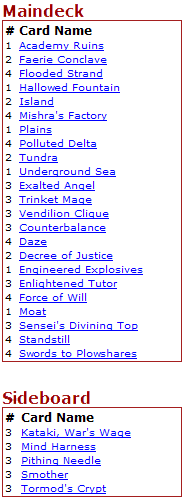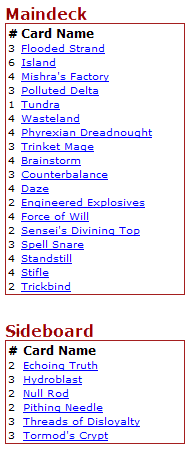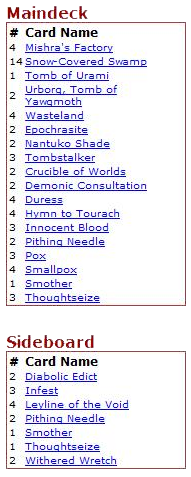Hello everyone, and welcome to MTGOAcademy. My name is Walkerdog on MTGO, or Tyler if you prefer. I’ve been playing Magic since Mirrodin/Kamigawa Standard, which isn’t that long in the big picture. I quickly developed a strong fondness for the sixty-card formats. Eventually I got online with MTGO and from there was drawn into Classic when I was told that it actually was something of an aggro-friendly format.
I enjoy Classic to this day, although my tastes have expanded past the joys of laying a Kird Ape on turn one off of a Stomping Ground. So, why should you care about Classic? Well, it is a thriving, healthy, and widely varied format. That is true of most of constructed Magic right now, but especially Classic. There are viable control, aggro, and combo strategies, and something of a Rock-Paper-Scissors meta exists. Just because a wonderful format awaits your explorations within it might not be enough to draw you in or get you to pay attention to it, so what if I mentioned that it could mean significant amount of money in your collection?
Classic has historically been a format that has caused seemingly random cards to suddenly gain in value. Phyrexian Dreadnought, Flash, Natural Order, and Grindstone are all examples of Eternal-only cards that have gained in value due to errata, new cards being printed, or new decks being put together. Classic Quarter members made a KILLING back in the day buying up Flash and Dreadnoughts post-errata and then re-selling them as they became very important parts of the format.
Some cards are going to go up in value by nature of the format. We’ve seen Lion’s Eye Diamond, Force of Will, and Standstill as cards that have no, or almost no, application outside of Classic (100 card singleton is the main exception) rise from an initially low value to rise to over four times their lowest cost. If you simply drafted a few of them and held them until their resale value was extremely high and sold them, you made money. If you had the foresight to buy any of these cards in bulk, you made a large amount of money.
Finally, some cards do drop in value, and being able to anticipate this and ride it is important to not losing value from your collection and potentially gaining value. Take Pernicious Deed for example. It is the PREMIER sweeper in Magic in most situations, but it’s a little clunky. Once valued at over $100, the card took a series of hits to its value. Some were foreseeable and some were not. Wizards first started “printing” more packs of Invasion, Planescape, and Apocalypse, in the form of IPA sealed tournaments that were qualified for by making the Top 8 in selected PEs. This had an impact on the price of all IPA cards which suddenly dropped a decent amount across the board due to people who had previous hoarded IPA card, even borderline junk with limited application (the rare counterspells for example) that saw play only in formats like Prismatic and Singleton at the time. Realizing that they would likely not be able to choke off the value of these cards, many people reversed course and began to liquidate their collections, in piecemeal or in whole.
Next, Extended, which was the primary place to play with IPA at the time, neared time for rotation which would push out IPA, Odessey-Torment-Judgement block AND Onslaught-Legions-Scourge block all from Extended. At this point, many people who owned only IPA-forward cards complained (and that’s putting it kindly) that their money cards would rotate from the format, and tried two proposals: Keep Extended as simply IPA-forward from now on, or make a new format split, Classic and IPA-forward, call it awful, or 1.yuck. While their concerns were understandable, these people had made the mistaken decision to rely on expensive cards never becoming less expensive just because, hey, they are expensive!
Wizards’ response (if you want to believe the decision was a result of these complaints) was to make Extended simply the last five years of cards. This kept OLS Fetchlands around which almost everyone agreed was a good thing, as they make for a fun format most of the time, and meant that Mirrodin block would rotate a year sooner, also A Good Thing in most people’s minds.
So, Deed dropped again down to around 32 tickets, which is the max amount you can trade in a single trade. Again, people looked at the card, thought “It’s a premier sweeper, it’s a hard-to-find card, it will hold its value!” It didn’t. Now playable only in Classic-based formats, and with more sweeper and sweeper-like effects seeing print every set (Maelstrom Pulse being the latest), it has crapped out, dropping down to 20 tickets. Had people who held it the entire time sold early (say they got 50 out of it) then re-bought now, they would have made 30 tickets by simply selling a card that was going to drop, and whose drop was pretty easy to see coming. Even re-buying at 30 would have realized a 20 ticket profit.
So, there is a fairly strong monetary incentive to knowing Classic. Now, what is Classic? Classic is the “Eternal” format on MTGO. That means you can play four copies of virtually any card in your collection. There is a Restricted list, meaning you can play only one copy of cards that are on this list. This list comprises some of the most broken cards online, but does have some seemingly curious cards that are not on the list.
Restricted in Classic:
Flash – How good was Flash? Good enough to get two cards restricted from it AND a third prerestricted in Imperial Seal from MED 2, which was our next card on the list.
Vampiric Tutor
Demonic Tutor – another auto-restrict and a good call.
Necropotence
Demonic Consultation
The last two both took a hit due to combining to form a VERY stable combo deck in NecroSpike. Consultation COULD have stuck around a bit longer, but it was just a broken combo enabler that functioned way too well. So, we have our Restricted list, which has been exclusively stopping broken combo decks thus-far in the format’s relatively short history.
Next, let’s look at the controlling strategies in the format. I will cover aggro and combo next time. Control in Classic tends to waver between mind-numbingly effective and boring, causing slow matches and long rounds in tournaments. On the plus side, some of us just like to draw counters and removal (cuz what other cards that are good are there?), slowly lock up the opponent, and chip away with random kill conditions.
I’ll start with Landstill. This is almost the DEFINITION of grinding control, seeking to steal a card here or there, play lands, remove your threats, and pile up some more lands. Eventually they’ll finish you with a Mishra’s Factory, a few Decree of Justice tokens or an Exalted Angel.
Here’s a sample list from Classicquarter.com, credited to Fatmaninalittlecoat:

As you can see, this is a very unfriendly deck for creatures. Moat, Angels, fetchable and recurable Engineered Explosives, Swords to Ploweshares, and on and on. This deck tends to eat a creature alive. For the current metagame, this might be a good solution with some tweaks. Right now, the feared decks are Elves!, Zoo, Merfolk, and Loam. This deck has Moat game one to shut down aggression, then merely needs to ride a few flyers to victory. Counterbalance gives it a long-game against Zoo and Elves! , and your tutors provide utility for almost any situation. I think that a little better answer to Mer might be needed, but we’re in a good place with this build.
Personally, to adapt this deck to the current meta, I would cut Daze, which is bad against almost every deck at the top right now due to their ability to play around it or just out-counter you, plus, it sets you back on tempo too much. Instead, I would probably run Spell Snare, which is REALLY good against a lot of the best decks and think about cutting Decrees for a full CounterTop setup. Faerie Conclave is a little slow for the current decks AND is too vulnerable to Wasteland; I would cut them for Wastelands and see if I could squeeze in one Crucible of Worlds. Finally, I’d probably want 1-2 more Engineered Explosives in the deck.
Counterbalance
So, from old-school to new-school, we’ll move into the next deck. Counterbalance locks have been a big part of Eternal formats for the last year or two, beginning most especially with Billy Moreno’s build of Flash back at GP Columbus with a CounterTop sideboard. Counterbalance is an absurd card, and when you pair it with more absurd cards, you get a nice blend of brokenness. Some of the typical cards in a CB deck:
Creatures: Tarmogoyf, Trinket Mage, Phyrexian Dreadnought, Dark Confidant, Tombstalker, and Nimble  Mongoose.
Mongoose.
Set-up and support: Brainstorm, Ponder, Force of Will, and a fairly even mix of one and two-casting cost spells, to be able to hopefully counter anything your opponent offers up. Some three-casting cost spells to be able to clean up randomness at three.
Past that, you can add in some sort of removal and another engine (Such as Intuition and Life from the Loam, Stifle, Trickbind, and Wasteland, or even combine CB with Standstill) and try to stick a Counterbalance, lock out the opponent, and win. To our left, we have a sample list of Dreadstill, which chooses to run the Stifle/Wasteland/Trickbind engine alongside Counterbalance and Standstill, combined with Phyrexian Dreadnoughts for fat. Again, thanks to Classicquarter for posting lists, and to Gimlicolby who piloted this build.
I would probably want a splash for Black at this point so I can splash Dark Confidant and some mixture of Smother and Diabolic Edict into the deck along with Engineered Plague, but the deck is very solid as-is. The land destruction package hits a lot of decks hard, and this is one of the few decks (along with Mer) that does not mind stuttering on tempo to throw a Daze at a spell.
World without Blue

Let’s move away from Blue into a couple of decks that are controlling, but don’t say, “No!” to do so, instead relying more on the strength of the mighty Black. Pox is the first of the two, and is a fairly budget-friendly deck. Dunkle_Stille has had a lot of success with the deck, so I’m just going to present his list, then discuss it a little.
His deck also plays a hybrid of fat men and land destruction with Tombstalker and Pox/Wasteland/Smallpox, along with creature control and the ability to recur his lands. The sideboard is all hate, with Leyline, Infest, Pithing Needle and Withered Wretch all taking big chunks out of established archetypes. The only consideration you have to make is whether this many creatures are necessary or if The Rack should be replacing some of them as an alternate kill conditions.
Green-Red-Black
The next deck is one with a lot of options and is a lot of fun to play. While I feel it is just a little TOO fair and  slightly too slow, it is a powerful strategy, and once it gets its engine firing, is nigh-unbeatable. It is a Green-Red-Black deck with multiple ways to win and many approaches to problems, along with silver bullets for any concerning cards. It runs many of the strongest cards in the format, in Tarmogoyf, Life from the Loam, Dark Confidant, Mox Diamond, and Burning Wish. This is Rukcus’s list. He is a strong supporter of Loam, and feels it is one of the better decks in the format. The list follows.
slightly too slow, it is a powerful strategy, and once it gets its engine firing, is nigh-unbeatable. It is a Green-Red-Black deck with multiple ways to win and many approaches to problems, along with silver bullets for any concerning cards. It runs many of the strongest cards in the format, in Tarmogoyf, Life from the Loam, Dark Confidant, Mox Diamond, and Burning Wish. This is Rukcus’s list. He is a strong supporter of Loam, and feels it is one of the better decks in the format. The list follows.
The most standard path to victory for the deck is a Turn one or two Chalice of the Void set to one, followed by some beaters and removal, finished by a tutor (Burning Wish or Demonic Tutor) for whatever needed finisher you want.
The most absurd start the deck can have, shy of T1 Chalice, is, “Fetchland, break it for a land, Mox Diamond pitching a land, Loam back two lands”. Very nice. Dark Confidant and Countryside Crusher combine nicely (most of the time, barring being at 1-2 life).
The deck functionally runs 5 copies of any sideboarded sorcery due to the tutors in the deck, and also runs an extra copy of any card in the maindeck due to the Demonic Tutor. This makes it very consistent and flexible, able to tutor up an answer to almost any scenario, from Hull Breach for any offending artifact or enchantment, to Chainer’s Edict to pop a creature, Worm Harvest as a recurable kill-condition, and Devastating Dreams as a finisher against a lot of decks.
The weak point in the deck is that it moves at the speed of slow. Blindingly fast start DO occur, but barring, “Turn one Mox Diamond,” you’re skipping the ability to play one-drops on turn one, or turn three along-side a two-drop, or EVER. This makes the deck highly reliant on finding an early Diamond or on the opponent not blowing them away by the fourth turn. For this reason, the deck tends to have a miserable matchup against Burn. Fat men in the deck alongside removal and swingy land destruction and sweepers allow the deck to beat up on Zoo, which lacks the option to just go “over the top” and throw fire every turn.
There are some other controlling options for this format, but we’ll stop here for now. Next time I’ll bring some popular and successful aggro and combo strategies and talk about their place in the meta.
Thanks for reading, and have a good one.
